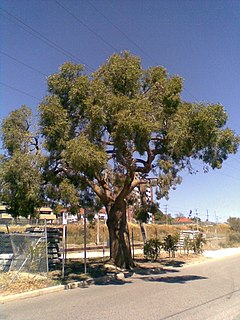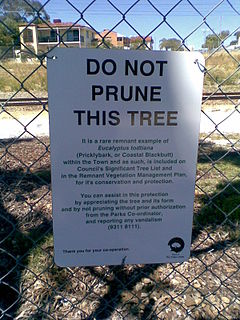Eucalyptus todtiana
| Eucalyptus todtiana | ||
|---|---|---|
 Un árbol remanente en el Parque Victoria, Australia Occidental | ||
| Taxonomía | ||
| Reino: | Plantae | |
| División: | Magnoliophyta | |
| Clase: | Magnoliopsida | |
| Subclase: | Rosidae | |
| Orden: | Myrtales | |
| Familia: | Myrtaceae | |
| Subfamilia: | Myrtoideae | |
| Tribu: | Eucalypteae | |
| Género: | Eucalyptus | |
| Especie: |
E. todtiana F.Muell. | |
Eucalyptus todtiana es una especie de eucalipto perteneciente a la familia de las mirtáceas.
Nombres comunes incluyen "blackbutt", "oastal blackbutt" y "pricklybark".[1]
Descripción
[editar]E. todtiana crece a una altura aproximada de 15 metros. Tiene un hábito llorón y una corteza rugosa con fibras café/grisáceas duras y finas.[2]
Produce flores cremosas y blancas desde enero a abril.
Distribución y hábitat
[editar]Generalmente crece cerca de las crestas de las elevaciones bajas arenosas blancas/grises o amarillas, con frecuencia sobre lateritas y más comúnmente mezclada con jarrahs y marris en el oeste y banksias y robles hembras en el este.[2] Prefiere suelos ligeros, bien drenados en una posición abierta y soleada.[2]
La distribución ocurre principalmente entre Perth y Dongara en la Provincia Botánica del Suroeste, Cinturón de trigo de Avon, Planicies arenosas de Geraldton, bosque de Jarrah y la llanura costera de Swan.[3]

Debido a los decrecientes bosques remanentes dentro del área metropolitana de Perth, los árboles individuales están llegando a ser menos comunes.
Historia
[editar]Fue por primera vez descrito por Ferdinand von Mueller en 1882, basado en los especímenes recolectados cerca de los ríos Greenough y Arrowsmith, y también de los que recogió John Forrest cerca del Río Moore. El nombre específico le hace honor a Emil Todt, un artista botánico.[4] Ha tenido una historia taxonómica sin incidentes, sin subespecies ni variedades, y tampoco sinónimos.[5] En la más reciente clasificación infragenérica se le ha colocado en E. subg. Eucalyptus, sect. Hesperia, ser. Todtianae.[6]
Cultivo
[editar]E. todtiana no es muy frecuentemente cultivado. Crece rápidamente como un arbolito si se le planta en una posición abierta, pero como adulto crece lentamente y florece de manera profusa.[7]
Taxonomía
[editar]Eucalyptus todtiana fue descrita por Ferdinand von Mueller y publicado en Southern Science Record 2: 171. 1882.[8]
- Etimología
Eucalyptus: nombre genérico que proviene del griego antiguo: eû = "bien, justamente" y kalyptós = "cubierto, que recubre". En Eucalyptus L'Hér., los pétalos, soldados entre sí y a veces también con los sépalos, forman parte del opérculo, perfectamente ajustado al hipanto, que se desprende a la hora de la floración.[9]
Referencias
[editar]- ↑ «Australian Plant Common Name Database». Australian National Botanic Gardens. Consultado el 23 de octubre de 2007.
- ↑ a b c «Remnant Vegetation Plan». Town of Victoria Park. August 2004. Archivado desde el original el 2 de septiembre de 2007. Consultado el 23 de octubre de 2007.
- ↑ «Eucalyptus todtiana». FloraBase (en inglés). Departamento de Medio Ambiente y Conservación, Gobierno de Australia Occidental.
- ↑ Hall, Norman (1978). Botanists of the Eucalypts. Australia: Commonwealth Scientific and Industrial Research Organisation. ISBN 0-643-00271-5.
- ↑ «Eucalyptus todtiana F.Muell.». Australian Plant Name Index (APNI), IBIS database. Centre for Plant Biodiversity Research, Australian Government.
- ↑ «Series Todtianae». EucaLink. Archivado desde el original el 2 de septiembre de 2007. Consultado el 23 de octubre de 2007.
- ↑ Powell, Robert (1990). Leaf & Branch. Department of Conservation and Land Management. ISBN 0-7309-3916-2.
- ↑ «Eucalyptus todtiana». Tropicos.org. Missouri Botanical Garden. Consultado el 10 de marzo de 2014.
- ↑ En Flora Vascular
Enlaces externos
[editar]- «Eucalyptus todtiana Pricklybark ; Coastal blackbutt». Kensington Bushland Reserve - Town of Victoria Park. Consultado el 23 de octubre de 2007.
Text is available under the CC BY-SA 4.0 license; additional terms may apply.
Images, videos and audio are available under their respective licenses.
